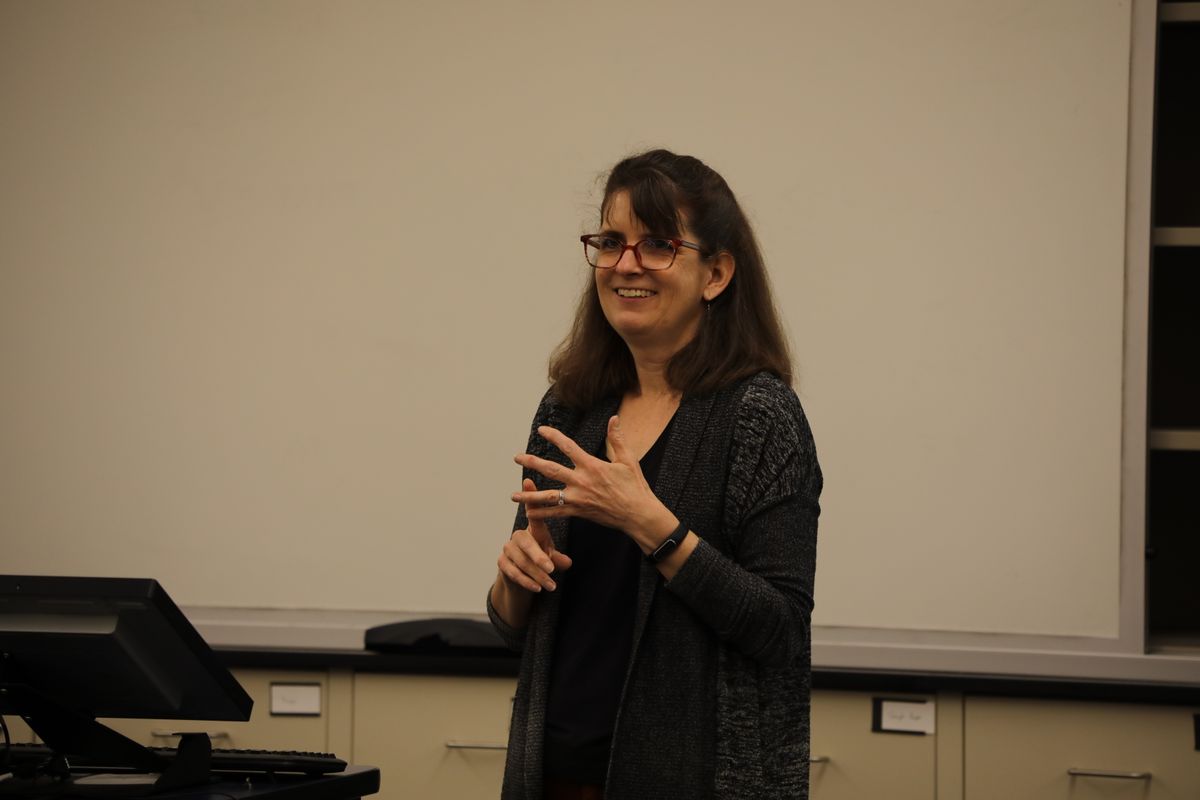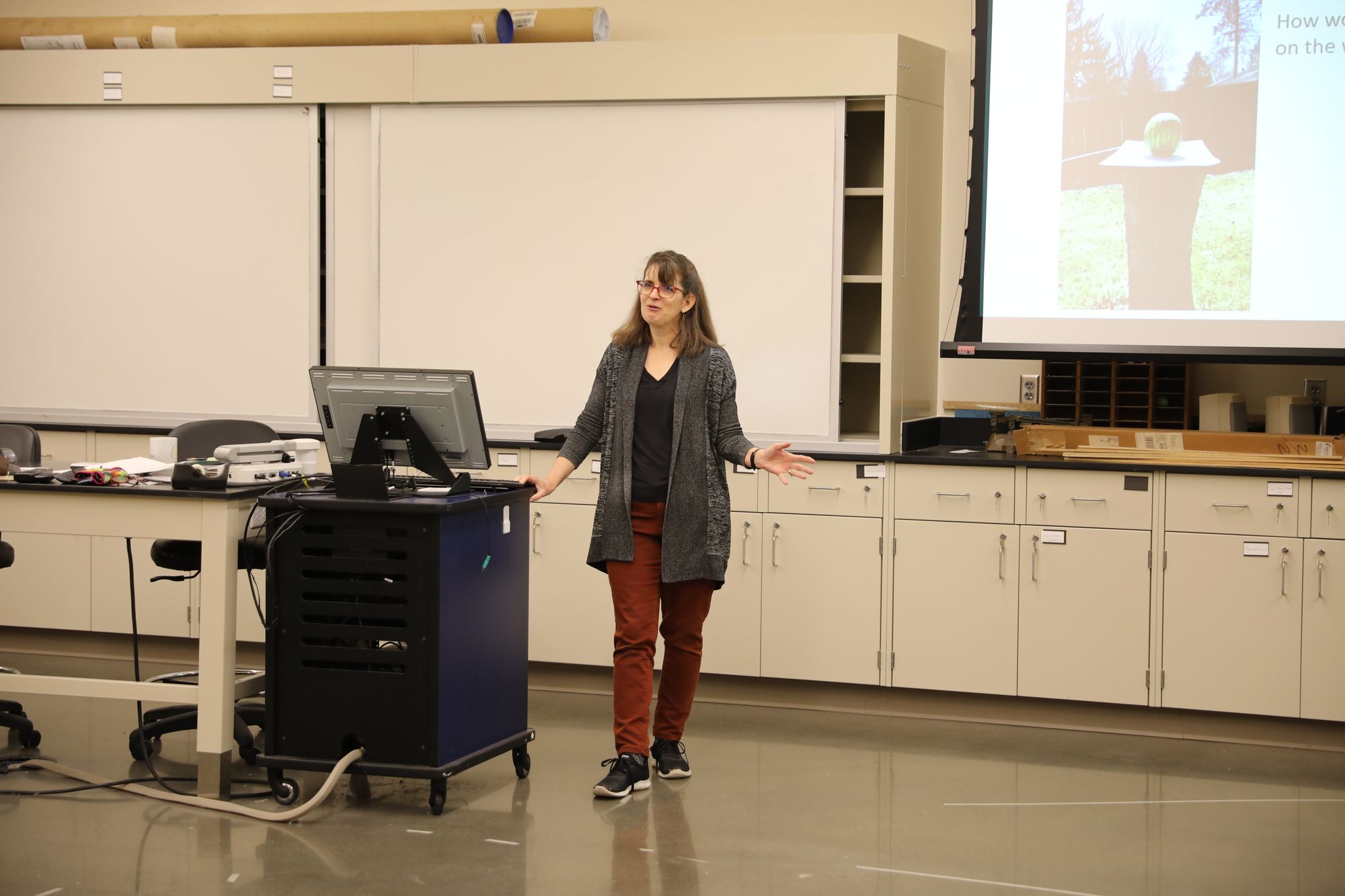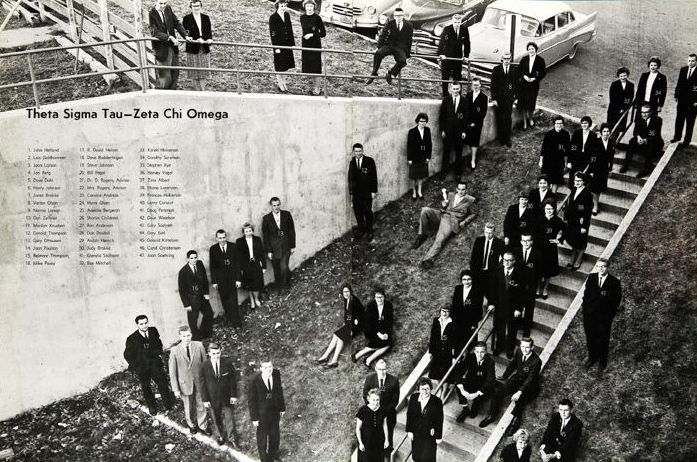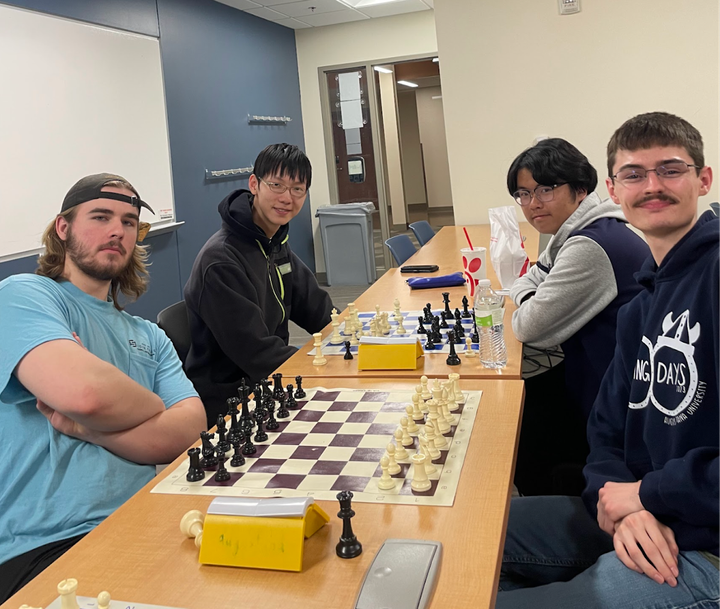Physics professor represents women in STEM

In spring 1987, college freshman Amy Bylsma sat in the back left corner in the last row of her Calculus III class. It was incredibly unlike her. She was usually one of those students who sat front and center, but the course wasn’t going well for her. She had a B-minus.
A problem posed on the board painted a picture of a rocket with a changing mass and derivatives with fluctuating velocities. The solver had to figure out how far the rocket could go. After concluding his explanation of the problem, Bylsma’s professor said, “But this is boring. This is physics.”
For Bylsma, though, the rocket problem was the first – and only – thing she had found interesting in her entire Calculus III course. After her class session, she decided it was time to try a course in physics.
Ultimately, Amy Kathleen Bylsma Engebretson graduated from Carleton College in 1990 with a bachelor’s degree in physics and earned her doctorate in physics from Michigan State University in 1998.
She had one child in graduate school, but never let that slow her down. Engebretson’s unique position as a female physicist created barriers she had to overcome. Through strength and persistence, she figured out how to be a mother and a physicist.
According to The American Institute of Physics, in 1987, women made up only 9% of physics bachelors and doctors. Engebretson said only five of the 20 physics majors in her graduating class were women, but they never felt like a minority.
These women were all consistently at the top of their class. According to Engebretson, they felt like they needed to justify their positions there. They sat in the front row, earned high test scores and answered challenging questions.
Engebretson took her first physics course her sophomore year of college with one of her friends. When Engebretson’s first test came, she freaked out.
“I called [my friend] up on the phone, and I said, ‘How do you find the acceleration?’ and he’s like, ‘Amy, don’t be stupid,’ and hung up,” Engebretson said.
On her first physics test, Engebretson got a B. Her friend got a better score. She subsequently beat her friend on every physics test that followed.
Engebretson was always competitive like that. In seventh grade, her math teacher would put the top 10 best test scores in the class on the board. The drive to be on the board created the habit of checking her work. When Engebretson’s test scores began climbing up the list, her teacher saw her potential and began tutoring her after school. Engebretson was then accepted into advanced math when she started high school.
Naturally, Engebretson was also competitive in her undergrad because of her place as a woman in physics. She felt like she had to prove why she was there, and she did that by continually being at the top of her class.
“Stubborn?” Engebretson said. “No, it’s called persistent.”
Following her parents, who were both teachers, Engebretson was sure she wanted to teach. Her parents encouraged her curious mind. To have the career she wanted, though, she would have to get her doctorate.
One week after her undergraduate graduation, Amy Kathleen Bylsma married Daniel Scott Engebretson. Her husband still had one year left of his undergraduate, so she deferred her graduate school options for a year. She also waited for him to apply so they could see where they were both accepted.
During her break from school, Engebretson used a different part of her skillset: being a saleswoman.
“I sold used hotel furniture,” Engebretson said. “That is an excellent way to motivate you to go to graduate school.”
The summer before she was scheduled to start classes, Engebretson was offered a physics research position at Michigan State, where both she and her husband decided to further their education.
At Michigan State, Engebretson specialized in condensed matter physics. Her class of 50 conducted research in the basement of one of the two physics buildings on Michigan State’s campus.
In the basement, there was no women’s restroom. The university eventually built an addition to the building where they put in a women’s restroom, but it was up a floor.
During Engebretson’s time in the basement, she was one of only three female graduate students in the group. People would often stop her and ask for directions or if she knew where something was, which she thinks is the result of the only other women in the building besides secretaries or physics store employees.
“I was always wondering, were they asking me directions because they thought I was a secretary and I would know where things were, or because they thought I was a student?” Engebretson said. “I never knew. I always wondered.”
Engebretson asked for a woman to be on her thesis committee, but there were no female professors in condensed matter theory or experiment. In fact, Engebretson never took a single class from a woman while in graduate school. The university allowed the school’s female astronomy professor to be part of her committee even though she did not specialize in the field Engebretson was studying.
In Engebretson’s second to last year of earning her doctorate, Michigan State hired a female physicist who specialized in condensed matter. Around the same time, the university hired a female technician to help in the labs with equipment.
When she picked her graduate advisor, Engebretson picked one with tenure and who she heard worked in research with a woman. She felt that it would be a good relationship because he would have equal respect for her.
“I picked one with tenure because if anyone gave me any problems, I wanted to have someone with some clout behind me,” Engebretson said.
Engebretson had a female friend at Michigan State who had to take remedial physics classes. She went to talk to a professor of one of her remedial classes, and when she sat down in his office, the first thing he asked the red-haired woman was, “Don’t you know that men find red hair sexy?”
“I never had anything like that happen to me,” Engebretson said. “Part of it was, I think, just because I was not in remedial classes.”
Engebretson had a good reputation, and because she was given many fellowships, she felt she was well-respected in the physics department.
A 2016 study by researchers from universities in Finland and Michigan studied the types of sexism women experience in the fields of physics and astronomy. The research found that, out of 21 women, 16 of them experienced gender microaggressions. Additionally, 5 out of the 21 women experienced hostile sexism. Luckily, Engebretson was in the minority in this case as well.
After she completed her four years of graduate school, Engebretson decided it was time to have a kid.
“[For] some people, physics is like their life, and it’s like all the nourishment they need,” Engebretson said. “I like physics. I think physics is interesting, but it is not my life.”
When Engebretson finished her research, she was pregnant with her second child and was exhausted. She defended her doctoral thesis — a book titled “Surface Acoustic Wave Investigation of Hydrogen Tunneling in Niobium Films at Low Temperatures” — while she was five months pregnant.
Engebretson was ready to stay home for a while. At her graduation reception, one of her professors congratulated her and told her he was glad that women have finally figured out how to have families and be physicists.
“I’m sorry, but I have to take some time off,” Engebretson said.
She felt like she was letting him down.
After taking time off to raise her children, Engebretson started her first job as a professor of physics at Minnesota State University Moorhead teaching physics labs.
“It was good because I was so sick of physics by the time I got my Ph.D.,” Engebretson said. “I started teaching their labs, and after a couple years, I thought, ‘I like physics again.’”

Engebretson taught there for three years before having her third child and taking the following year off. She taught one more year at Minnesota State University Moorhead, and then she and her family moved to Sioux Falls, South Dakota.
Engebretson got her job at Augustana University in 2005 and has been here since. She has three male physics professor colleagues, so the gender ratio of Augustana’s physics department is 25% female to 75% male.
According to an article by Physics Magazine editor Katherine Wright, women made up 21% of doctors of physics in 2018. This is an increase of 11% since Engebretson decided to major in physics in 1987.
Engebretson recognizes the work women studying in the field of physics must do to be properly recognized, but she also knows that women can do it.
“It is tiring to be the only one who’s like you,” Engebretson said. “So, when you feel like quitting, you just go in there and you start doing it.”



